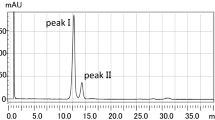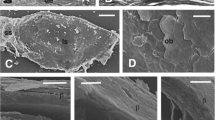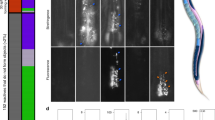Abstract
IN 1958 Owens et al.1, in reporting on the chemical composition of conidia of Neurospora sitophila, indicated a high percentage of lipids in which the most prevalent types were the phospholipids. The high lipid content of the conidia suggests that it may be a source of energy either in the ungerminated conidium or during germination, but the fact that these lipids are primarily phospholipids contests this hypothesis. Our investigation of the lipid content of conidia before and during germination was undertaken as part of a study of the biology of reproduction in Neurospora.
This is a preview of subscription content, access via your institution
Access options
Subscribe to this journal
Receive 51 print issues and online access
$199.00 per year
only $3.90 per issue
Buy this article
- Purchase on Springer Link
- Instant access to full article PDF
Prices may be subject to local taxes which are calculated during checkout
Similar content being viewed by others
References
Owens, R. G., Novotny, H. M., and Michels, M., Contrib. Boyce Thompson Inst., 19, 355 (1958).
Turian, G., Nature, 202, 1240 (1964).
Turian, G., C.R. Acad. Sci. Paris, 252, 1374 (1961).
Fillerup, D. L., and Mead, J. F., Proc. Soc. Exp. Biol. and Med., 83, 574 (1953).
Sussman, A. S., The Fungus Spore (Butterworths, 1966).
Author information
Authors and Affiliations
Rights and permissions
About this article
Cite this article
BIANCHI, D., TURIAN, G. Lipid Content of Conidia of Neurospora crassa. Nature 214, 1344–1345 (1967). https://doi.org/10.1038/2141344a0
Received:
Issue Date:
DOI: https://doi.org/10.1038/2141344a0
This article is cited by
-
Polarizing processes for germ tube outgrowth from monilioid fungal spores (Neurospora conidial model)
Proceedings / Indian Academy of Sciences (1985)
-
Lipids associated with microconidial differentiation in a mutant ofNeurospora crassa
Current Microbiology (1978)
-
Conidiation in Neurospora
The Botanical Review (1972)
-
Thermostimulation of conidiation and succinic oxidative metabolism of Neurospora crassa
Archiv f�r Mikrobiologie (1968)
Comments
By submitting a comment you agree to abide by our Terms and Community Guidelines. If you find something abusive or that does not comply with our terms or guidelines please flag it as inappropriate.



